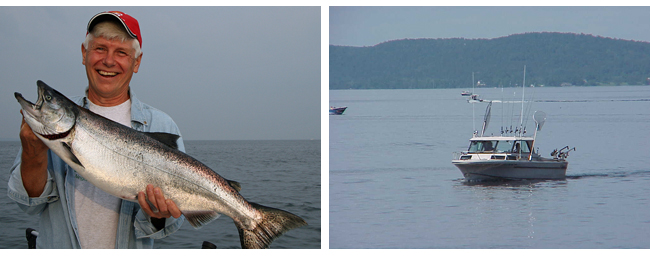Contacts:
- Jesse Lepak, New York Sea Grant, Great Lakes Fisheries and Ecosystem Health Specialist, P: 315-312-3042, E: jml78@cornell.edu
- Dr. James M. Watkins, Cornell University, Department of Natural Resources, E: jmw237@cornell.edu
- Kara Lynn Dunn, NYSG Great Lakes Publicist, P: 315-465-7578, E: karalynn@gisco.net
Oswego, NY, November 13, 2017 - New York Sea Grant has released a video highlighting the value of king salmon to the Lake Ontario ecosystem and local economies, and how Cornell University researchers and Sea Grant personnel are using pop-off satellite archival tags developed to work in freshwater to collect unprecedented data about salmon movement and behavior.
New York Sea Grant Fisheries and Ecosystem Health Specialist Jesse Lepak wrote and narrated the 3-minute video that shows the tagging process and highlights the value of the data collected by the tags.
“These freshwater pop-off tags allow for a unique view into the behavior of the fish and will provide data of interest to researchers, aquatic resource managers, and anglers,” Lepak said.
“For example, the tags are equipped with accelerometers indicating when the fish are swimming quickly to catch prey. Sea Grant will be sharing that information with the recreational anglers and charter services that are key economic drivers of the Lake Ontario regional economy,” Lepak noted.
A tag that was placed on a mature salmon on July 13 in waters near Oswego, NY, was detected on August 31 near Cobourg, Ontario, Canada, 90 miles away. That tag was recovered and contains data, including depth, temperature, and acceleration of the fish recorded at one-second intervals for 49 days. Read more about this in the Cornell Chronicle.

Extension of Cornell University fisheries research funded by New York Sea Grant will bring new insight on king salmon behavior to the charter fishing industry and recreational anglers. Credit: Wayne County Tourism
With funding from New York Sea Grant, Dr. James M. Watkins with the Cornell University Department of Natural Resources, Ithaca, NY, and biologist Dr. Christopher Perle of Florida State College, Jacksonville, FL, are analyzing the data from the tags that can provide up to 90 days’ worth of tracking information.
“With this tagging process, the fish become lake profilers. For example, data from the tags will track how closely the salmon follow their water temperature preference of 42 to 48 degrees Fahrenheit in the summer and when they choose to leave that preferred temperature to enter either warmer or colder waters in search of forage,” says Watkins.
Perle, who has been involved in marine electronic tagging research in the Pacific Ocean, notes, “Fresh water presents new challenges technologically for electronic ‘pop-up’ tags. This Sea Grant project will not only provide information about king salmon as a key predator in the ecology of Lake Ontario, it is an opportunity to evaluate a new tag designed specifically for fresh water.”
Two Lake Ontario charter fishing services assisted the production of the “Learning More About Lake Ontario’s King Salmon” video.
Fish Doctor Charters Captain Ernie Lantiegne, a retired New York State DEC fishery biologist, commented, “King salmon are the big draw for anglers in Lake Ontario and the main engine for its multimillion dollar salmonid fishery.”
Rochester Sport Fishing Charter Captain Kip Mammano agreed, “The king salmon fishery of Lake Ontario can be seen as an invaluable resource, and sustaining this world-class fishery should remain a priority for years to come.”
More Info: King Salmon Quick Facts
- King salmon are also called Chinook salmon.
- King salmon grow larger in Lake Ontario than any other Great Lake. They can reach lengths of more than 3 feet and weights of 30-plus pounds.
- King salmon were introduced into Lake Ontario to help control overabundant alewife prey fish populations in the 1960s and 1970s.
More Info: New York Sea Grant
New York Sea Grant (NYSG), a cooperative program of Cornell University
and the State University of New York, is one of 33 university-based
programs under the National Sea Grant College Program (NSGCP) of the
National Oceanic and Atmospheric Administration (NOAA). The NSGCP
engages this network of the nation’s top universities in conducting
scientific research, education, training and extension projects designed
to foster science-based decisions about the use and conservation of our
aquatic resources. Through its statewide network of integrated
services, NYSG has been promoting coastal vitality, environmental
sustainability, and citizen awareness about the State’s marine and Great
Lakes resources since 1971.
New York Sea Grant maintains Great Lakes offices at SUNY Buffalo, the
Wayne County Cooperative Extension office in Newark and at SUNY Oswego.
In the State's marine waters, NYSG has offices at Stony Brook University
and Stony Brook Manhattan, in the Hudson Valley through Cooperative
Extension in Kingston and at Brooklyn College.
For updates on Sea Grant activities: www.nyseagrant.org has RSS, Facebook, Twitter, and YouTube links. NYSG produces a monthly e-newsletter, "NOAA Sea Grant's Social Media Review," via its blog, www.nyseagrant.org/blog. Our program also offers a free e-list sign up via www.nyseagrant.org/coastlines for its flagship publication, NY Coastlines/Currents, which is published quarterly.